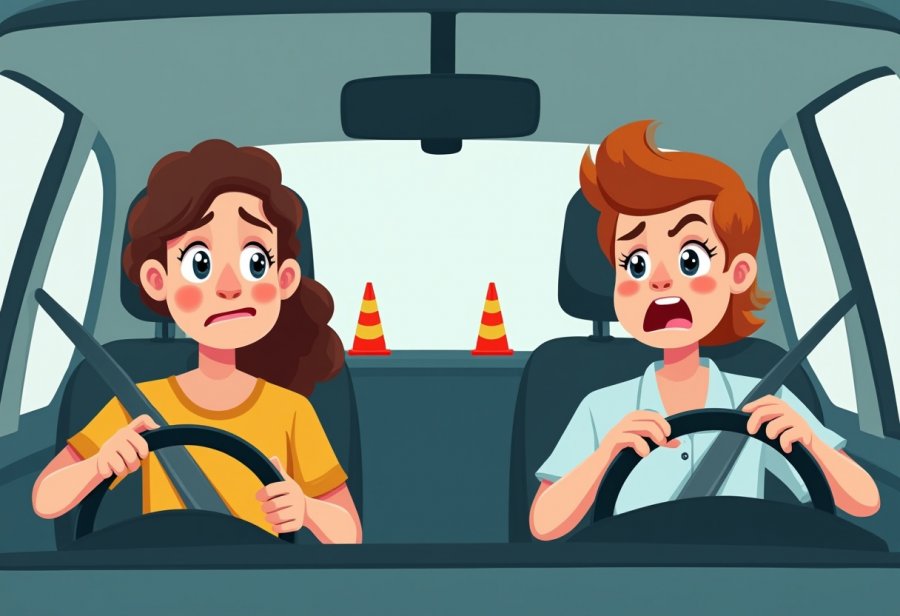
Learning to drive is widely celebrated as a pivotal step toward independence, yet beneath the excitement lies a complex emotional landscape marked by nerves, self-doubt, and internal struggles. Do these common anxieties—fear of making mistakes, managing pressure from peers and parents, and handling unpredictable road scenarios—actually intensify as teens progress? This journey isn’t just about mastering vehicle control; it’s about building trust in oneself amid a sea of internal doubts. The process demands significant emotional and financial investments, often leading teens to question whether the cost and effort are worth it. Despite visible progress, many grapple with hesitation and overthinking that hinder confidence and motivation, turning routine drives into stressful trials. Recognizing these internal conflicts as natural parts of growth can empower teens to embrace setbacks as opportunities for resilience. Ultimately, the road to confident driving becomes a profound journey of self-discovery, patience, and grit—transforming internal fears into lifelong strength.

Navigating the Emotional Road to Teen Driving Independence
Learning to drive is often celebrated as a major milestone of independence for teenagers—a moment when they step into a new level of freedom and responsibility. It’s a rite of passage that symbolizes growing up, and many teens look forward to the day they can take the wheel on their own. But beneath that excitement lies a complex web of emotions that can turn this milestone into a source of anxiety rather than pure joy.
For many young drivers, the first few lessons are filled with nerves. Sitting behind the wheel for the first time can feel overwhelming, as every sound, movement, and decision is new territory. The pride of learning to navigate the roads is often accompanied by hesitation, self-doubt, and even fear of making mistakes. These feelings aren’t signs of failure—they’re natural parts of the process that reflect how much they care about safety and doing well.
As teens practice more, some of that initial anxiety begins to fade, but internal struggles often linger. Even after mastering basic skills like steering and braking, doubts can creep in during high-pressure situations, such as busy intersections or bad weather. These internal fears can overshadow their progress, making every trip feel more stressful than it should be. It’s not just about controlling the car—it’s about trusting themselves to handle the unpredictable challenges of the road.
This emotional landscape is shaped by the desire for independence paired with the reality of inexperience. Many teens find themselves caught between excitement and fear, eager to gain freedom but wary of potential mistakes. These internal conflicts can cause hesitation, overthinking, and even avoidance of certain driving conditions, which slows their journey toward confidence. Recognizing that these feelings are common can help normalize the experience and reduce the pressure teens put on themselves.
The road to confident driving isn’t linear. It’s full of small victories, setbacks, and moments of self-doubt. Each challenge faced and overcome helps build resilience and self-trust—traits that extend well beyond the driver’s seat. Supporting teens through this emotional rollercoaster is key. Encouragement, patience, and celebrating progress—no matter how tiny—transform nerves into confidence and fear into growth.
Understanding that internal struggles are a normal part of learning to drive can make this journey less daunting. When teens realize that nerves and doubts are shared by many, they’re more likely to approach their lessons with patience and self-compassion. Each mile driven becomes not just a step toward independence but a chance for self-discovery—learning how to manage nerves, build trust, and develop resilience that will serve them for life.
Why Teen Drivers Feel Nervous and How It Shapes Confidence
Many teens feel nervous about driving because it’s a brand-new skill paired with significant responsibility. The road can seem like a confusing and unpredictable place when you’re just starting out. Worrying about making mistakes—like missing a turn, stalling, or forgetting to check blind spots—is common and can quickly undermine their confidence. Without enough experience, it’s hard to trust their own judgment, which only fuels feelings of uncertainty and self-doubt.
Peer pressure and parental expectations add another layer of stress. Teens often feel they need to prove themselves quickly, especially if friends are watching or parents emphasize perfect driving from the start. This pressure can make even simple trips feel like high-stakes tests, amplifying anxiety and hesitation. When every drive feels like a challenge, it’s easy to get caught in a cycle of worry and doubt.
The complexity of navigating busy streets, merging onto highways, or handling bad weather only increases their fears. Many teens feel overwhelmed by the thought of reacting correctly in tricky situations, which makes them hesitate more. This hesitation isn’t just about skill; it’s rooted in confidence. Without enough practice, their minds tend to run through worst-case scenarios, making calm decision-making harder in the moment.
Building trust takes time, but progress isn’t always visible. When teens focus on their mistakes or setbacks, they start doubting whether they’ll ever feel comfortable behind the wheel. This cycle of frustration and doubt can make every drive seem more intimidating. It’s a common experience that many young drivers face, and understanding that it’s part of the process can help normalize these feelings.
Fear of losing control is another major concern. Teens worry about emergency situations or aggressive drivers, and these fears can feel overwhelming when they haven’t yet experienced handling such scenarios successfully. Their minds tend to magnify these worries, often forgetting that most driving challenges can be managed with patience and practice.
Recognizing that these fears are normal helps teens see their worries as a natural part of learning. Many care deeply about safety and independence, which makes nerves understandable rather than a sign of failure. With time, patience, and support, these anxieties can be managed. Reframing fears as opportunities for growth encourages resilience and makes the journey toward confident driving more attainable.

Balancing Growth and Doubt: The Realities of Learning to Drive
Learning to drive today is a balancing act between visible progress and unseen internal doubts. Many teens start their journey eager to gain independence, yet beneath that excitement, anxiety often persists. They might quickly learn how to steer, brake, or park, but trust in themselves in unfamiliar or high-pressure situations—like heavy traffic or bad weather—remains fragile. Even after gaining confidence in basic skills, doubts can creep in, making each new challenge feel daunting and overshadowing their actual progress.
This internal tug-of-war—between outward growth and inner hesitation—reflects the reality many young drivers face. When a teen successfully navigates a tricky intersection or merges onto a highway, it’s celebrated as a victory. But those moments can be quickly clouded by fears of making mistakes next time, creating a cycle of hesitation and second-guessing. Over time, this cycle shapes how they experience driving, often making routine trips seem more stressful than necessary. Progress isn’t just about mastering techniques; it’s about building the internal trust to handle the road’s unpredictable moments.
Teen drivers often find themselves caught between their desire for independence and lingering fears. They might feel ready to drive alone or in complex conditions, yet hesitation or doubts hold them back. For example, a teen may be eager to drive in the rain or at night but feels overwhelmed by the thought of losing control or reacting incorrectly in emergencies. These worries don’t disappear overnight; they persist as part of the learning process, affecting motivation and practice. Support from family, patience, and celebrating small wins help shift focus from fear to confidence, easing the internal struggle.
Hesitation and overthinking during drives are common hurdles. Teens might freeze at a green light, unsure whether to go or wait, or repeatedly check mirrors without reason. Such behaviors are frustrating but normal—signs of their brains trying to process new information and build safety routines. With consistent practice and reassurance, they learn to accept that mistakes are inevitable and recoverable. Over time, this acceptance transforms anxiety into calm confidence, allowing them to focus on driving rather than their worries. Recognizing that setbacks are part of growth helps them develop resilience and trust in their abilities.
Despite visible progress, fears about handling emergencies, bad weather, or complex traffic often linger. These worries aren’t signs of failure but natural components of the learning curve. As they continue practicing and gaining experience, these fears gradually diminish, replaced by a deeper sense of trust. Understanding that internal doubts are normal makes the journey less intimidating, encouraging teens to face challenges with patience and self-compassion. Each drive becomes a step toward not only becoming a confident driver but also cultivating resilience that extends beyond the road.
For parents and instructors guiding young drivers, understanding the importance of emotional resilience can make a significant difference. Resources such as this guide on learning to drive can offer valuable insights and practical tips to help teens build confidence and overcome doubts, fostering safer and more positive driving experiences: learning to drive guide.
The Hidden Costs and Emotional Toll of Gaining Driving Freedom
Learning to drive involves more than just mastering the mechanics behind the wheel; it also demands a significant emotional and financial investment that many teens and their families underestimate. From the very beginning, costs can add up quickly—permit fees, driving lessons, and licensing expenses can strain budgets, especially when every gas fill-up, insurance premium, or car repair extends the financial toll. These ongoing costs can amplify feelings of frustration and stress, making the journey toward independence feel more overwhelming than exciting.
Beyond the money, the emotional weight is just as real. Teens often find themselves caught between a strong desire for freedom and the anxiety about making mistakes. Each driving session can feel like a test of their confidence and resilience, with worries about whether they’re spending too much time or money learning to drive. That emotional burden can cause feelings of inadequacy or self-doubt, making the process seem even more daunting and prolonging their path to comfort behind the wheel.
The combination of financial and emotional investments can turn learning to drive into a daunting challenge. Teens might second-guess whether they’re truly ready or wonder if the cost—both monetary and emotional—is worth it. This internal conflict can lead to hesitation, or even a desire to give up altogether, which delays their progress and deepens feelings of frustration. Recognizing these hurdles as normal parts of the process helps normalize the experience and encourages persistence.
There are ways to ease this burden. Seeking more affordable options, such as community programs, online resources, or practicing with trusted family members, can reduce costs without sacrificing skill development. Breaking the process into manageable steps and celebrating small victories along the way builds confidence and provides motivation. These wins serve as reminders that progress is happening, even when setbacks feel discouraging.
Ultimately, learning to drive is about more than attaining external skills—it’s about building internal resilience to handle both the financial and emotional challenges that come with the territory. Accepting that these investments are part of growth helps teens develop patience and self-compassion. Each obstacle—whether monetary or emotional—becomes a stepping stone toward greater independence, shaping not just their ability to navigate the roads, but also their approach to challenges in life.
By understanding that these costs and emotional efforts are integral to the journey, teens can approach driving with a healthier mindset. Instead of viewing setbacks as failures, they see them as part of the learning process—moments that foster strength and grit. This perspective transforms the experience from an obstacle into an opportunity for growth, making the road toward confident driving less intimidating and more empowering.
Supporting teens through this phase involves acknowledging the reality of these investments and encouraging a balanced view. Patience, encouragement, and celebrating every small success help turn stress into motivation. As they gradually overcome financial and emotional hurdles, they develop a sense of ownership over their progress, reinforcing that their growth is real and worth every effort.
In the end, the financial and emotional investments required to learn to drive are substantial, but they’re also shaping vital life skills. Patience, resilience, and self-belief cultivated along the way extend beyond the road, preparing teens for future challenges with confidence and grit. Recognizing this broader significance helps transform a potentially daunting process into a valuable journey of self-discovery and independence.

How Internal Doubts Influence Daily Drives and the Path to Confidence
Internal struggles often shape how teens experience their daily drives, turning routine trips into moments of doubt or hesitation. For many young drivers, nerves can cause them to second-guess simple decisions—pausing at green lights, overchecking mirrors, or hesitating before merging. These internal doubts create a hesitation loop that makes every trip feel more overwhelming, often leading teens to avoid challenging situations altogether. As a result, their progress toward genuine confidence slows, and driving feels less natural.
On the flip side, small wins can serve as powerful confidence boosters. When a teen manages to merge smoothly onto a busy highway or park confidently in a tight space, it’s more than just a success—it’s proof that they’re capable. These moments help shift their internal dialogue from fear to trust, gradually rewiring their mindset. Hearing stories from peers who’ve faced similar fears and come out stronger can also motivate teens to push through their doubts, reinforcing that internal struggles are normal and manageable.
Internal doubts don’t only impact confidence—they influence motivation. When anxiety takes hold, teens might avoid practicing altogether, missing crucial opportunities for growth. This avoidance can deepen feelings of helplessness, making them question whether they’ll ever feel truly comfortable behind the wheel. Conversely, positive reinforcement from family or friends, like celebrating small achievements, can help redirect focus from worry to progress. These moments remind teens that setbacks are part of learning, not signs of failure.
Overthinking during drives is another common challenge. Teens might freeze at a green light, unsure whether to go, or repeatedly check their mirrors without any real reason. While frustrating, these behaviors are typical signs of their brains trying to process unfamiliar information and build safe habits. With ongoing practice and reassurance, they begin to accept that mistakes are inevitable and recoverable. This acceptance fosters a calmer mindset, allowing them to focus more on driving and less on their fears.
As teens gather more experience, their internal dialogue often shifts from anxiety to reassurance. They start recognizing that most mistakes aren’t catastrophic, and that they can handle unexpected situations with patience. This shift doesn’t happen overnight but grows steadily as they face and overcome small challenges. Each successful drive reinforces that their fears are manageable, building resilience that extends beyond the road into other areas of life.
Fears about handling emergencies or tricky conditions tend to linger, even after gaining some confidence. Worries about bad weather or aggressive drivers are common, but they gradually diminish as teens practice in varied environments. Understanding that internal doubts are a normal part of growth helps normalize these fears, making them easier to manage. With patience and continued exposure, teens learn to trust their judgment, transforming internal hurdles into stepping stones.
Watching internal struggles play out in real-world driving highlights how much this process is about more than just mechanics. It’s about learning to navigate uncertainty, manage nerves, and develop resilience. Each trip, each mistake, and each small victory shape their confidence and independence. When teens see that internal doubts are shared by many, they’re more likely to approach driving as a journey of growth rather than a test of perfection.
In the end, internal struggles are woven into the fabric of learning to drive. Recognizing and accepting these challenges empowers teens to face them head-on, turning nerves into confidence and hesitation into trust. Every drive becomes an opportunity—not just to master the road but to understand themselves better. That’s the real road to independence: a path paved with patience, persistence, and self-discovery.


